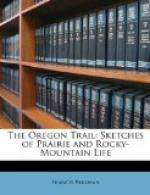So we all galloped forward together, prepared for a hard fight; for these bears, though clumsy in appearance and extremely large, are incredibly fierce and active. The swell of the prairie concealed the black object from our view. Immediately after it appeared again. But now it seemed quite near to us; and as we looked at it in astonishment, it suddenly separated into two parts, each of which took wing and flew away. We stopped our horses and looked round at Henry, whose face exhibited a curious mixture of mirth and mortification. His hawk’s eye had been so completely deceived by the peculiar atmosphere that he had mistaken two large crows at the distance of fifty rods for a grizzly bear a mile off. To the journey’s end Henry never heard the last of the grizzly bear with wings.
In the afternoon we came to the foot of a considerable hill. As we ascended it Rouville began to ask questions concerning our conditions and prospects at home, and Shaw was edifying him with a minute account of an imaginary wife and child, to which he listened with implicit faith. Reaching the top of the hill we saw the windings of Horse Creek on the plains below us, and a little on the left we could distinguish the camp of Bisonette among the trees and copses along the course of the stream. Rouville’s face assumed just then a most ludicrously blank expression. We inquired what was the matter, when it appeared that Bisonette had sent him from this place to Fort Laramie with the sole object of bringing back a supply of tobacco. Our rattle-brain friend, from the time of his reaching the Fort up to the present moment, had entirely forgotten the object of his journey, and had ridden a dangerous hundred miles for nothing. Descending to Horse Creek we forded it, and on the opposite bank a solitary Indian sat on horseback under a tree. He said nothing, but turned and led the way toward the camp. Bisonette had made choice of an admirable position. The stream, with its thick growth of trees, inclosed on three sides a wide green meadow, where about forty Dakota lodges were pitched in a circle, and beyond them half a dozen lodges of the friendly Cheyenne. Bisonette himself lived in the Indian manner. Riding up to his lodge, we found him seated at the head of it, surrounded by various appliances of comfort not common on the prairie. His squaw was near him, and rosy children were scrambling about in printed-calico gowns; Paul Dorion also, with his leathery face and old white capote, was seated in the lodge, together with Antoine Le Rouge, a half-breed Pawnee, Sibille, a trader, and several other white men.




